The Lobo MAX-80
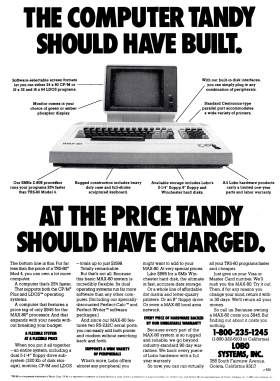
Lobo Systems advertisement from the December 1983 issue of 80 Micro
The Lobo MAX-80 was a TRS-80 compatible computer sold by Lobo Systems (originally known as Lobo Drives International). Introduced at the 1982 National Computer Conference (where one could be reserved for a $100.00 deposit), the MAX-80 offered an impressive array of features including:
- a Z80B running at 5.07 MHz (making it one of the fastest microcomputers at the time)
- 64K of memory standard, with sockets for an additional 64K
- a double-density floppy disk controller with support for both 5 1/4" and 8" drives
- a hard disk controller interface
- video support through a standard RCA phono jack
- a screen size of 64 by 16 or 80 by 24 with a partially redefinable character set
- a TRS-80 style keyboard with CONTROL and ESCAPE keys, as well as F1 through F4
- one parallel port
- two serial ports
- real time clock with battery backup
There was a great deal of interest in the MAX-80 and articles about it were published in all of the TRS-80 magazines. A MAX-80 Users' Group, MAXIMUL, was formed which published a newsletter devoted to the MAX-80.
Compatibility
Unlike other TRS-80 compatibles, such as the PMC-80 or the LNW80, the MAX-80 wasn’t hardware compatible with the TRS-80. It shared some hardware characteristics, such as memory-mapped keyboard and video. But there were many differences from the Model I and Model III, including different disk hardware, no cassette support and no BASIC in ROM. As a result, no self-booting TRS-80 disks would work on the MAX-80, whether they were operating systems or games.
In many respects, the MAX-80 had more hardware similarities to the Model I than the Model III. But in terms of software compatibility, the MAX-80 was based on the Model III. According to some estimates, 95% of all Model III software (excluding games) would work unmodified on the MAX-80. Games were a separate problem because they usually relied on direct hardware access and the slower TRS-80 speed. Almost all major TRS-80 software packages were compatible, and Logical Systems sold a $10.00 patch disk of fixes for those that exhibited problems (such as VisiCalc and Scripsit).
Operating Systems
Much like the earlier Lobo LX-80 Expansion Interface, the MAX-80 required a special version of LDOS to run TRS-80 programs. Lobo Systems offered two different operating systems for the MAX-80:
- CP/M 2.2, and later CP/M 3.0, came supplied with the MAX-80 and was regarded as an especially good implementation of CP/M.
- LDOS, from Logical Systems, was able to run most TRS-80 Model III programs.
There were two other MAX-80 operating systems available from third parties:
- MULTIDOS, from Cosmopolitan Electronics Corporation, was largely compatible with MULTIDOS for the TRS-80 Model III.
- MaxDOS, introduced by MicroConsultants and Riclin Computer Products in 1985 and later sold by Bryan Headley, was a patched version of Model 4 LS-DOS that remained completely compatible with standard LS-DOS software. This was a remarkable achievement when you consider that the MAX-80 predated the Model 4.
There were also plans for a MAX-80 version of DOSPLUS, but I haven’t found any evidence that it was ever released.
Hardware
The MAX-80 was a complete computer in a 17″ by 10″ keyboard unit (which consumed only 28 watts). A standard configuration originally cost $820.00 for a 64K unit and CP/M. An additional 64K cost $95.00. Later on, the standard configuration changed to a 128K unit for $945.00.
All that was required to make a complete system was a monitor and disk drives. Many types of standard monitors could be used and Lobo Systems sold a 12″ monitor for $175.00. They also sold a variety of disk drive units, including:
- dual 40 track 5¼″ single-sided floppy drives for $690.00
- one 80-track double-sided floppy drive for $1,175.00
- dual single-sided 8″ floppy drives for $1,185.00
- dual double-sided 8″ floppy drives for $1,485.00
- one 4.8 MB hard drive (Winchester) for $2,100.00
Lobo also sold a “well-equipped” MAX-80 system (128K keyboard unit, monitor, and two 5 1/4" drives) for $1599.00.
Support
With its 5.07 MHz processor, the MAX-80 was one of the fastest microcomputers available at the time. Although its lack of graphics and color deterred some, it remained an attractive choice for those who wanted both CP/M and LDOS compatibility. However there is little doubt that the introduction in 1983 of the TRS-80 Model 4, a 4 MHz computer which offered both CP/M and complete Model III compatibility, must have dampened interest in the MAX-80.
In 1985, Lobo Systems announced a new computer called the Mini Max. It was a $795 transportable computer designed to compete with the TRS-80 Model 4P. I don’t know if any were produced, and both Lobo and the Max-80 disappeared soon after.
MAXIMUL and their MAX-80 newsletter both outlasted Lobo Systems, ending only in 1989. MaxDOS also remained available until at least 1988.
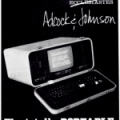
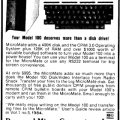
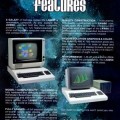
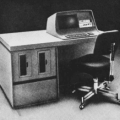










Chuck de Young says:
This is the computer I most regret not having today! I owned one of these fine machines in the 1980’s, and came from a TRS-80 background, but this was the time period that I was working in CP/M and the Lobo became my main machine. I had dual DD DS 8" drives, as well as multiple 5.25" floppies, but never a hard drive.
I remember falling asleep to the clicking and whirring of the drives, and the blinking of the LEDs as some big job was running. I wrote some very good code on that machine, and it is not going too far to save I loved it. Like the Velveteen Rabbit, I put it aside as I moved into the world of the PC, and I actually remember that for awhile I had two, and now I have none, but I do not remember how I parted with it.
I would love to have one again, with the eight inch drives, and all, but I have never seen one for sale. The Max-80 was a great computer, LDOS was a fine operating system, and I have been very fond of other computers I have owned in the 25 years since then, but this might have been the one, the single best machine ever.
Chuck
Phil says:
Wow – this site brings back memories. I was in high school (or the equivalent) in England and since I couldn’t afford the TRS-80 I had a Video Genie. A far east copy of the hardware that ran all these games and other software.
I can’t believe that I’d forgotten Starfighter… I played that game for hours and it held my imagination as much as any game since.
Thanks for the site :)
Bryan says:
Yes, DOSPlus IV existed for the Max-80.
Tom Briscoe says:
From the original Small-C article in Dr. Dobbs Journal I was able to create a port to the TRS-80 using Zilog mnemonics and the Microsoft Z80 assembler. I did most of the work on my Max-80 and later moved up to James Hendrix’s Small-C v.2. I also had CP/M 3 when it came out, but I found a free Z-80 source CP/M clone called ZDOS and managed to get that running, to which I added a free Z-80 assembler I found published in a book. Topping it all off with a small screen-oriented text editor I wrote in Small-C gave me a complete system, entirely in source code. Those were the days!